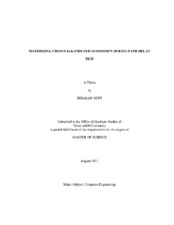Maximizing Crosstalk-Induced Slowdown During Path Delay Test
Abstract
Capacitive crosstalk between adjacent signal wires in integrated circuits may lead to noise or a speedup or slowdown in signal transitions. These in turn may lead to circuit failure or reduced operating speed. This thesis focuses on generating test patterns to induce crosstalk-induced signal delays, in order to determine whether the circuit can still meet its timing specification. A timing-driven test generator is developed to sensitize multiple aligned aggressors coupled to a delay-sensitive victim path to detect the combination of a delay spot defect and crosstalk-induced slowdown. The framework uses parasitic capacitance information, timing windows and crosstalk-induced delay estimates to screen out unaligned or ineffective aggressors coupled to a victim path, speeding up crosstalk pattern generation. In order to induce maximum crosstalk slowdown along a path, aggressors are prioritized based on their potential delay increase and timing alignment. The test generation engine introduces the concept of alignment-driven path sensitization to generate paths from inputs to coupled aggressor nets that meet timing alignment and direction requirements. By using path delay information obtained from circuit preprocessing, preferred paths can be chosen during aggressor path propagation processes. As the test generator sensitizes aggressors in the presence of victim path necessary assignments, the search space is effectively reduced for aggressor path generation. This helps in reducing the test generation time for aligned aggressors. In addition, two new crosstalk-driven dynamic test compaction algorithms are developed to control the increase in test pattern count. The proposed test generation algorithm is applied to ISCAS85 and ISCAS89 benchmark circuits. SPICE simulation results demonstrate the ability of the alignment-driven test generator to increase crosstalk-induced delays along victim paths.
Citation
Gope, Dibakar (2011). Maximizing Crosstalk-Induced Slowdown During Path Delay Test. Master's thesis, Texas A&M University. Available electronically from https : / /hdl .handle .net /1969 .1 /ETD -TAMU -2011 -08 -10127.


